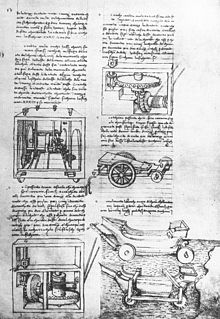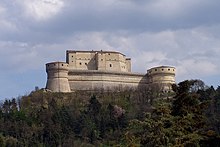
Back فرانشيسكو دي جورجيو Arabic Франческо ди Джорджо Bulgarian Francesco di Giorgio Martini Breton Francesco di Giorgio Catalan Francesco di Giorgio Martini Czech Francesco di Giorgio Martini German Francesco di Giorgio Martini Esperanto Francesco di Giorgio Spanish Francesco di Giorgio Martini Basque فرانچسکو دی جورجو Persian



Francesco di Giorgio Martini (1439–1501) was an Italian architect, engineer, painter, sculptor, and writer. As a painter, he belonged to the Sienese School. He was considered a visionary architectural theorist—in Nikolaus Pevsner's terms: "one of the most interesting later Quattrocento architects".[1] As a military engineer, he executed architectural designs and sculptural projects and built almost seventy fortifications for the Federico da Montefeltro, Count (later Duke) of Urbino, building city walls and early examples of star-shaped fortifications.
Born in Siena, he apprenticed as a painter with Vecchietta. In panels painted for cassoni he departed from the traditional representations of joyful wedding processions in frieze-like formulas to express visions of ideal, symmetrical, vast and all but empty urban spaces rendered in perspective.
He composed an architectural treatise Trattato di architettura, ingegneria e arte militare, the third of the Quattrocento, after Leone Battista Alberti's and Filarete's; he worked on it for decades and finished sometime after 1482; it circulated in manuscript.[2][3] The treatise was included in several original manuscripts with one copy (i.e., Codex Mediceo Laurenziano 361) belonged to Leonardo da Vinci who had made notes and sketches within.[4] The projects were well in advance of completed projects at the time, but innovations, for example in staircase planning, running in flights and landings round an open center, or dividing at a landing to return symmetrically on each wall, became part of architectural vocabulary in the following century.[5] The third book is preoccupied with the "ideal" city, constrained within star-shaped polygonal geometries reminiscent of the star fort, whose wedge-shaped bastions are said[6] to have been his innovation.

Francesco di Giorgio finished his career as architect in charge of the works at the Duomo di Siena, where his bronze angels are on the high altar and some marble floor mosaics are attributed to his designs. The design of the church of San Sebastiano in Vallepiatta in Siena is also attributed to him.
Francesco di Giorgio's painting of the "Madonna and Child with 2 Angels" is found at the Lowe Art Museum in Coral Gables, Florida.
- ^ Pevsner, An Outline of European architecture 1963:192.
- ^ Center for Palladian Studies in America, Inc., Palladio's Literary Predecessors Archived 2018-12-17 at the Wayback Machine. The treatise was not printed until 1841, in Turin.
- ^ di Giorgio Martini, Francesco (1841). Cesare Saluzzo (ed.). Trattato di Architettura Civile e Militare (no figures). Tipografia Chirio E Mina, Turin.
- ^ Reti, Ladislao; Martini, Francesco di Giorgio (1963). "Francesco di Giorgio Martini's Treatise on Engineering and Its Plagiarists". Technology and Culture. 4 (3): 287–298. doi:10.2307/3100858. ISSN 0040-165X. JSTOR 3100858. S2CID 113038460.
- ^ Pevsner 1963:281
- ^ Siegfried Giedion, Space, Time and Architecture, 4th ed. 1962:43, fig. 6.
© MMXXIII Rich X Search. We shall prevail. All rights reserved. Rich X Search